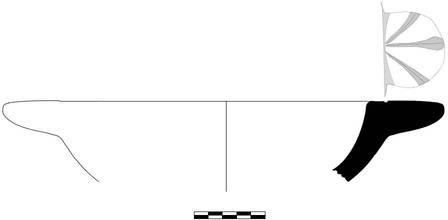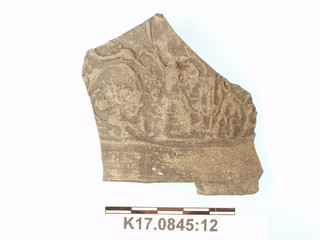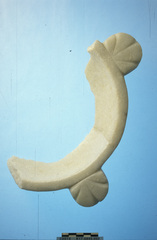Greek, Roman and Byzantine Pottery at Ilion (Troia):
Sebastian Heath and Billur Tekkök, Editors
Fills Cut by Foundation Trench of Post-Severan Construction
Please note that this is a public draft of work in progress
1. Molded Pyxis Base (Early Roman)
P. H. .071. Est. diam. base .13 (1/6 preserved). Th. .032.
K17.0845:12. Single sherd, lower wall and single applied foot. Dark gray (Gley 1 – 10Y 3/), slightly granular fabric with tiny white inclusions visible against the dark matrix. There are also rare large lime chunks, .002 in length, flattened on the surface or visible in the break, and a single large white chunk, 4.2mm, exploding in foot; single surface void. The surface is coated dark gray (Gley 1 N 3/) where not abraded. The decorative scheme is only partially restorable. A heron leans in from the left but only its long neck and head is preserved. It is pecking at a bunch of grapes. Beneath the heron’s neck is a long stem with further vegetal design below. This left part is relatively clear. The subject is unclear to the right. It seems to be a dense thicket of vines, no human or animal forms are recognizable. The only somewhat well-defined feature is a vertical cluster which starts as one line at its bottom but becomes two. The scene is reminiscent of early first century Italian motifs.
K17.0845-12.jpg
2. Eastern Sigillata Bi Hayes Form 40 Beaker Base (early first AD)
P. H. .017. Est. diam. base .07 (1/3 preserved). Th. .0027.
K17.0845:8. Single sherd, lower wall and floor. Micaceous brown (5YR 6/6) fabric, thick red (2.5YR 4/8) slip. Concentric grooves on underside and a single groove on lower exterior wall.
Cf. , p. 61, tavola XIII.12.
svg/K17.0845-8.jpg
3. Çandarli Hayes Form 3 Rim (late 2nd to 3rd century)
P. H. .026. Th. .004.
K17.0845:9. Single rim sherd, diameter not recoverable. Light red fabric (2.5YR 6/8) with small light and other dark inclusions, small voids. Pronounced outer edge of flange. The red (between 10R 4/8 and 5/8) slip is equally applied on all extant surfaces.
svg/K17.0845-9.jpg
4. Çandarli Hayes Form 2 Bowl Rim
P. H. .019. Est. diam. rim .20 (<1/10 preserved). Th. .006.
K17.0845:5. Single rim sherd. Light red (10R 6/6) fabric with frequent small light and dark inclusions and occasional voids up to .0035 in height. Gold mica visible in the fabric and flattened on the surface. The interior surface is worn but extant slip is dark for Candarli (between 10R4/4 and 4/6). The exterior is thinly slipped, unsmoothed, and lighter (10R 5/4) than the interior. Possibly burned.
svg/K17.0845-5.jpg
5. Çandarli Hayes Form 2 Bowl Rim
P. H. .02. Est. diam. rim ~.30 (1/10 preserved). Th. .0045.
K17.0845:6. Single rim sherd. Light reddish-brown (2.5YR 6/6) fabric with frequent small light inclusions. The red (10R 5/8) slip is thickly applied to the interior surface and well polished. The exterior slip is thinner with scratches.
svg/K17.0845-6.jpg
6. Çandarli Hayes Form 4 Base (200-300)
P. H. .026. Est. diam. base near .10 (<1/20 preserved). Th. .006.
K17.0845:4. Single base sherd. Compact fabric, unevenly fired with slightly brown (2.5YR 6/6) core in relation to the brighter (2.5YR 6/8) surrounding clay, difference is subtle. Occasional inclusions consist predominantly of rounded or elongated light bits. No mica. Occasional voids. The red (near 10R 5/8) slip is polished on the interior but not on the exterior which exhibits scratches.
svg/K17.0845-4.jpg
7. African Red-Slip Hayes 50 Type Base (AD 230-320)
P. H. .045. Th. .0025.
K17.0845:7. Single sherd with initiation of vestigial base. Compact orange (near 10R 6/8) fabric with occasional small, light inclusions. Slip is slightly darker on interior.
svg/K17.0845-7.jpg
8. Unclassified Small Red-Slipped Unguentarium (Late Roman?)
P. H. .0165. Est. diam. base .05 (1/3 preserved). Th. .006.
K17.0845:15. Single base sherd. Hard, compact light red (2.5YR 6/6) fabric with occasional lime exploding on interior surface. There is a gray subsurface patch near the base just under the interior surface, this does not continue around the whole of the extant sherd. The worn surface is slipped and fired to an uneven red/orange (from 2.5YR 5/8 to 6/8). The interior of the vessel shows deep grooves. The exterior unevenly banded. A large void (.0143 long) appears on the exterior surface just above turning of floor.
svg/K17.0845-15.jpg
9. Gritty Gray Cookingware Flanged Casserole
P. H. .051. Est. diam. rim .30 (1/7 preserved). Th. .0055.
K17.0845:3. Single rim sherd, flange and inturned rim to lower floor. Brown (5YR 4/6) fabric with occasional large quartz, up to .001, and frequent angular light bits. All preserved surfaces are a uniform dark gray. Exterior is ridged.
Cf. P51.
svg/K17.0845-3.jpg
10. Middle Roman Amphora 3 (“Micaceous Water Jar”) Neck and Handle
P. H. .061. Th. .004.
K17.0845:10. Single sherd partially preserves neck and single complete handle. Fine brown (5YR 4/4) fabric with rare tiny white inclusions and frequent mica, typical for form. Interior surface is thinly coated with dark pitch.
svg/K17.0845-10.jpg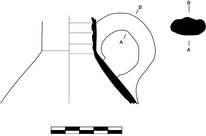
11. Middle Roman Amphora 5 Rim
P. H. .038. Est. diam. rim .19 (1/6 preserved). Th. .012.
K17.0845:13. Single sherd, deep grooves under rim. Coarse, dark brown (7.5YR 4/3) at core of rim with frequent varied angular inclusions and gold mica. Exterior surface is predominantly orange (near 2.5YR 6/6), the upper face of the rim and extant inner part of the neck is gray except where worn.
K17.0845-13.jpg
12. Middle Roman Amphora 5 Handle
P. H. .11.
K17.0845:11. Single sherd preserves part of handle. Hard granular, brown (5YR 6/8 and browner) fabric with frequent white angular inclusions. Thin dull red (near 10R 5/6) coat on surface.
svg/K17.0845-11.jpg
13. Middle Roman Amphora 7 Handle
P. H. .062.
K17.0845:14. Single sherd partially preserves handle. Hard, compact reddish-brown (2.5YR 5/8) fabric with frequent small reddish and light inclusions. Coated surface is slightly darker and browner than fabric.
svg/K17.0845-14.jpg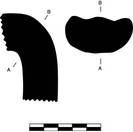
14. Marble Bowl with palmette lug handles
H. .049. Est. diam. rim .23 (1/2 preserved). Th. .0152.
K17.0845. S0016.
Large grain white marble with some gray veining.
Two large joining fragments.
Bowl with rounded wall, no part of floor extant; two palmette handles preserved. The rounded wall rises directly to flat rim. The handles are similar in conception, though not identical in result. They are both elongated semi-circles. In section they are gently rounded on top, with a continuous vertical side and more rounded lower face. Each is divided into four parts by three v-shaped grooves that are deeper towards the outer edge. In one handle these grooves meet at a straight line dividing the handle from the rim. The center groove extents to the inner edge of the rim, where it is faint. On this handle the flanking grooves have a slight flare. The other handle has one groove that crosses onto the rim and misses the intersection of the central groove and rim; the other flanking groove is more carefully placed. The central groove of this handle does not seem to cross onto the rim. This second handle is larger than the better executed one. [[handles will be labeled a and b when illustrated]]
svg/S0016.jpg